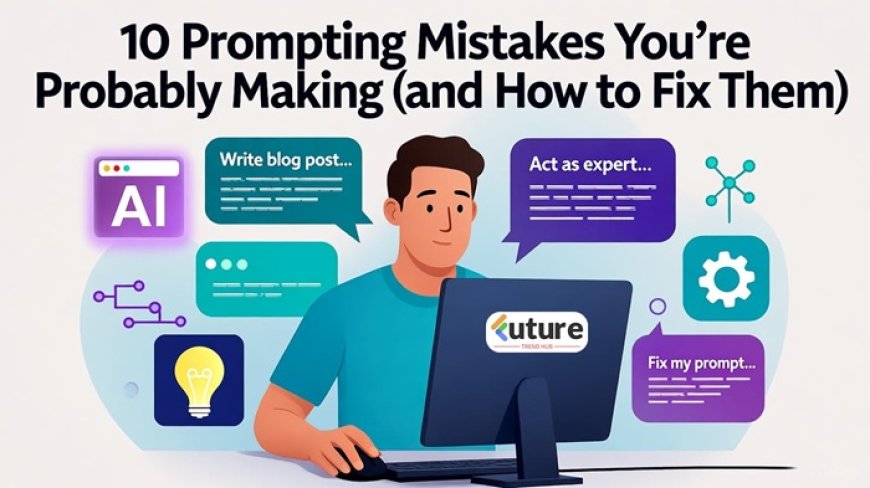10 Prompting Mistakes You’re Probably Making (and How to Fix Them)
Learn the top 10 common mistakes people make when writing AI prompts — and how to fix them. Discover expert tips, real examples, and practical strategies to get better responses from ChatGPT, Gemini, and other AI tools.

If you’ve ever asked ChatGPT or any AI model a question and got a vague or off-target answer, you’re not alone. The problem usually isn’t the AI — it’s the prompt.
Writing effective prompts is a skill. And like any skill, it’s easy to get it wrong before you get it right. After helping teams and individuals refine their AI workflows, I’ve noticed a pattern — the same 10 mistakes keep showing up.
Let’s break them down, one by one, with practical examples you can apply immediately.
1. Being Too Vague
The mistake:
Typing something like “Write a blog post on AI.”
Why it fails:
That’s like asking a stranger to “talk about food.” You’ll get something generic, flavorless, and uninspired.
Fix it:
Add specifics — audience, tone, and context.
✅ “Write a 600-word blog post on how AI is helping small business owners manage time, written in a conversational tone.”
👉 The more clarity you provide, the better the response.
2. Ignoring Context
The mistake:
Jumping into a prompt without giving AI any background.
Why it fails:
AI doesn’t know your goal, role, or situation unless you tell it.
Fix it:
Set the stage before asking.
✅ “You are a content strategist helping a travel blogger grow on Instagram. Suggest post ideas with captions and hashtags.”
That one sentence of context can completely change the quality of the output.
3. Forgetting the Role Assignment
The mistake:
You let AI be a generalist.
Why it fails:
Without direction, the AI behaves like a polite but clueless assistant.
Fix it:
Assign a role to the AI.
✅ “Act as a marketing consultant with 10 years of experience in digital campaigns.”
Role assignment makes the model think like an expert — giving you depth instead of surface-level advice.
4. Not Setting Format or Structure
The mistake:
You expect neatly organized answers without asking for them.
Why it fails:
AI doesn’t know your preferred format — bullet points, paragraphs, tables, etc.
Fix it:
Guide the format.
✅ “List five points with short explanations for each, and summarize at the end.”
It’s a small detail that can double your productivity.
5. Asking for Too Much in One Go
The mistake:
Stuffing multiple requests in one prompt.
“Write an article, make SEO tags, and summarize it — in one message.”
Why it fails:
AI gets confused by multiple priorities.
Fix it:
Break it into steps.
✅ Step 1: “Draft the article.”
✅ Step 2: “Now create SEO title and tags.”
Modular prompting = cleaner results.
6. Ignoring Iteration
The mistake:
You take the first answer as final.
Why it fails:
Prompting is a conversation, not a command.
Fix it:
Iterate!
✅ “Good start. Can you make it more persuasive and add examples?”
Each tweak improves the outcome — like polishing a rough gem.
7. Not Using Examples
The mistake:
Expecting AI to understand your style without a reference.
Why it fails:
AI learns from patterns. No pattern = random style.
Fix it:
Provide a sample.
✅ “Write in the tone of this paragraph [insert example].”
You’ll instantly get more consistent, brand-aligned results.
8. Overcomplicating Language
The mistake:
Using fancy or confusing phrasing in prompts.
Why it fails:
AI understands natural, clear instructions — not riddles.
Fix it:
Be simple and conversational.
✅ “Explain AI in a way a 10-year-old can understand.”
The simpler your words, the smarter the output.
9. Ignoring Limitations
The mistake:
Expecting real-time data, personal opinions, or emotional empathy.
Why it fails:
AI isn’t human. It predicts text patterns — it doesn’t “know” or “feel.”
Fix it:
Use AI as an assistant, not an oracle.
✅ “Summarize what experts have said about this topic up to 2024.”
It keeps your expectations (and your prompts) realistic.
10. Forgetting to Review Outputs
The mistake:
Copy-pasting AI content blindly.
Why it fails:
Even great prompts can produce factual or tonal errors.
Fix it:
Review, edit, and personalize.
✅ Add your insights, experiences, and voice.
That’s what makes content yours — and it’s the key to both authenticity and SEO quality.
🎯 Final Thoughts
AI isn’t just a tool — it’s a partner that mirrors your clarity. If your prompts are vague, rushed, or unrealistic, the results will reflect that.
The secret isn’t about writing perfect prompts — it’s about writing intentional ones. Treat AI like a teammate who’s brilliant but needs clear direction, and you’ll be amazed at what you can co-create.
🧩 Quick Recap
✅ Be specific
✅ Add context
✅ Assign roles
✅ Define format
✅ Work in steps
✅ Iterate
✅ Give examples
✅ Stay simple
✅ Respect limitations
✅ Always review
Author’s Note:
This article is based on hands-on experience testing prompts across ChatGPT, Gemini, Grok, and Claude for business, marketing, and creative writing. These aren’t theories — they’re lessons learned from hundreds of real-world conversations.







